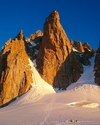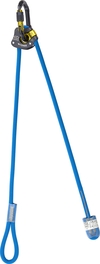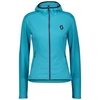Sulamar North Face first ascent by Mick Fowler and Paul Ramsden

 1 / 5
1 / 5 archive Mick Fowler
archive Mick Fowler
British climbers Mick Fowler and Paul Ramsden have returned from a month-long trip to the Chinese Tien Shan range where they carried out the first ascent of the North Face of Sulamar (5380m) in the Xuelian massif.
The original objective had been the north-west ridge of Xuelian East, but they opted against this due to dangerous snow conditions and so they set their eyes on an eye-catching line on Sulamar, which has been first ascended in 2008 by the Americans Bruce Normand, Guy McKinnon and Paul Knott via the NE flank. Fowler and Ramsden breached the prominent 1600m central buttress by climbing alpine style for four days and encountered difficulties up to TD+.
The two then set about exploring the previously unvisited Chulebos peaks via the historic Xiate trail, now fallen into disuse due to the broken glaciers. Fowler stated "Walking up a glacier which had never been visited by climbers before was good invigorating stuff. And while we were there, we found plenty of great objectives for the future – there is so much to be done! All in all, this expedition has been very pleasing."
Fowler and Ramsden often team up together and in 2002 they were awarded with the Piolet d’Or for their first ascent of the Central Couloir on Siguniang's North Face, China. We used this opportunity to find out a little more from Fowler himself, from the man that Sir Chris Bonnington once described as being one of Britain's greatest mountaineers.
Mick, China seems to be high on your agenda. How do you rate these territories?
Very highly! For me the great thing about China is that there are so many unclimbed and unknown mountaineering objectives in interesting and rarely visited areas. Chinese mountaineers have historically focused exclusively on 8000m peaks with the result that there are whole areas of 5000m - 7000m peaks that have never been visited by mountaineers. Special permits are often required and the bureaucratic challenges are high - but I view that as adding to the challenge and it keeps the crowds away!
You've been in this game for decades. How do you see your mountaineering evolving?
Mine? While my body still allows me I intend to carry on doing much the same as I do now. My ultimate plan is always to climb an eye catching unclimbed line in an area which is culturally interesting, has never before been visited by mountaineers and is doable in 4 weeks from Britain - that being the part of my annual leave allowance that I devote to mountaineering. That's a tall order I know and it's not always possible - but that's what I set out to do.
And what about mountaineering in general?
I think it depends what you mean by 'evolving.' As wealth and free time increase in countries like China and India I expect we will see more mountaineers in those countries and that could put real pressure on unclimbed objectives. The style of future ascents I see as as being important. Small lightweight teams benefit from less cost and greater flexibility and big heavyweight expeditions look outdated now. We are already starting see a small number of lightweight teams climbing technical routes on 8000m peaks and that is a trend I see continuing. As equipment gets better and lighter I think we can expect climbers to be out longer on Alpine Style ascents and achieve harder and harder climbs. Within this I would like to think that pressure on objectives and peer pressure through internet chat rooms and forums will see ethics and the exact style of ascent becoming increasingly important. And there will doubtless be a continuing 'evolution' of those wishing to break records in the mountains. I am sure we can look forward to plenty of eye opening achievements!
Can you see different approaches to the mountains and mountaineering, depending on which country someone come from?
I think there have been different approaches in the past but with increasing globalisation of standards in general I sense that the approach is more consistent now than it used to be. The focus seems to be moving towards small, lightweight ascents with activists throughout the world often in contact with each other. And if someone steps badly out of line the internet forums can be merciless!
How much are you willing to give to reach a summit?
My view is much the same now as it has always been. I am willing to suffer in terms of putting up with bad weather, no food, hanging bivouacs and the like but objective risks such as rockfall and avalanches are things that I go out of my way to try and avoid. I like to feel that I have a degree of control over the risks that all mountaineers face and the likely dangers are factors that I consider closely when choosing an objective.
You tend to climb in the smallest of teams. Do you ever consider going it alone?
No. I enjoy climbing as safely as possible and spending time in the mountains with my friends. I don't like to rush and my climbing partners and I like to take lots of photographs of each other in action to maximise our retrospective pleasure. This would not be possible if I was alone.
Why do you shun the Himalayan giants?
They are crowded, I like my brain cells and I can't get enough time off work.
Talking of which, you have a full time job, a family... not the best basis for intensive training. How do you go about preparing for your expeditions?
I do a bit of fell running and race about every other week in the winter. I am usually in the last quarter of the field but I enjoy it and it keeps the heart and lungs going. Beyond that I try and get out with a group of friends every Wednesday evening - rock climbing in the summer and caving, kayaking, biking, running or night climbing in the winter. All that gives me a basic level of fitness - but I think willpower is at least as important as fitness in the Greater Ranges.
| Links Planetmountain | |
| British Manamcho Expedition 2007 | |
| News Mick Fowler | |
| www | |
| www.thebmc.co.uk | |



 Copia link
Copia link
























